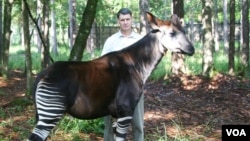The hunt continues for the Mai Mai militia that attacked a DRC conservation project in June. Six people were killed, as well as 14 endangered animals called Okapi, or forest giraffe.
The attack occurred around 5 a.m. on June 24 at the Okapi Conservation Project in Epulu. It is believed to have been retaliation by poachers for efforts to stop their activities inside the Okapi Wildlife Reserve.
Project founder and director John Lukas said the Mai Mai Simba rebels are led by Morgan Sadala.
“He’s a resident of the reserve. He’s been a poacher for a long time. The reserve was only created in 1992. This gentleman just wants to kill elephants and mine gold. The Satori area has large deposits of alluvial gold, which is in the rivers, and it’s a very destructive process to get it out. It’s mined outside of the reserve legally, but inside the reserve it’s illegal to do and that’s what we’re trying to stop,” he said.
Rangers from the Institute in the Congo for the Conservation of Nature have been closing Sadala’s mines and confiscating poached ivory. Lukas said that’s why the project was attacked.
It’s estimated there are 10,000 to 20,000 Okapi in the wild. The exact number is unclear because the animals, who live only in the DRC’s rainforest, are so elusive. About 4,000 are in the wildlife reserve. They look like a cross between a zebra and a giraffe, and weigh between 600 and 800 pounds.
Lukas said it took 48 hours following the attack for Congolese and U.N. soldiers to arrive on the scene. While the militia is blamed for the killings, slaughtering the Okapi and burning buildings, he blames Congolese troops for looting the buildings.
He now hopes they’ll try to track down Sadala and his rebels, but he said they may not have an incentive to do so.
“Right now,” he said, “it’s really touch and go. The soldiers are ready to be deployed, hopefully towards the area where the rebels flee. We really have a high concern of military involvement with the rebels and that’s a major concern. We’re addressing that in Kinshasa and other places. We feel there is a complicit relationship between some of the military and the poachers, and so that’s something we have to work out. And we have to mount a major campaign to find this group.”
He described U.N. troops who came to the area as “totally ineffective.” Lukas said they just go to the river, “take a bath and leave.”
The U.N. stabilization mission in the DRC, with its 20,000 troops and more than 700 military observers, is known as MONUSCO. It’s authorized “to use all necessary means to carry out its mandate relating, among other things, to the protection of civilians, humanitarian personnel and human rights defenders under imminent threat of physical violence.”
A number of Epulu townspeople, who were taken hostage by the Mai Mai to carry stolen goods, have been released and have returned home.
The attack occurred around 5 a.m. on June 24 at the Okapi Conservation Project in Epulu. It is believed to have been retaliation by poachers for efforts to stop their activities inside the Okapi Wildlife Reserve.
Project founder and director John Lukas said the Mai Mai Simba rebels are led by Morgan Sadala.
“He’s a resident of the reserve. He’s been a poacher for a long time. The reserve was only created in 1992. This gentleman just wants to kill elephants and mine gold. The Satori area has large deposits of alluvial gold, which is in the rivers, and it’s a very destructive process to get it out. It’s mined outside of the reserve legally, but inside the reserve it’s illegal to do and that’s what we’re trying to stop,” he said.
Rangers from the Institute in the Congo for the Conservation of Nature have been closing Sadala’s mines and confiscating poached ivory. Lukas said that’s why the project was attacked.
It’s estimated there are 10,000 to 20,000 Okapi in the wild. The exact number is unclear because the animals, who live only in the DRC’s rainforest, are so elusive. About 4,000 are in the wildlife reserve. They look like a cross between a zebra and a giraffe, and weigh between 600 and 800 pounds.
Lukas said it took 48 hours following the attack for Congolese and U.N. soldiers to arrive on the scene. While the militia is blamed for the killings, slaughtering the Okapi and burning buildings, he blames Congolese troops for looting the buildings.
He now hopes they’ll try to track down Sadala and his rebels, but he said they may not have an incentive to do so.
“Right now,” he said, “it’s really touch and go. The soldiers are ready to be deployed, hopefully towards the area where the rebels flee. We really have a high concern of military involvement with the rebels and that’s a major concern. We’re addressing that in Kinshasa and other places. We feel there is a complicit relationship between some of the military and the poachers, and so that’s something we have to work out. And we have to mount a major campaign to find this group.”
He described U.N. troops who came to the area as “totally ineffective.” Lukas said they just go to the river, “take a bath and leave.”
The U.N. stabilization mission in the DRC, with its 20,000 troops and more than 700 military observers, is known as MONUSCO. It’s authorized “to use all necessary means to carry out its mandate relating, among other things, to the protection of civilians, humanitarian personnel and human rights defenders under imminent threat of physical violence.”
A number of Epulu townspeople, who were taken hostage by the Mai Mai to carry stolen goods, have been released and have returned home.
